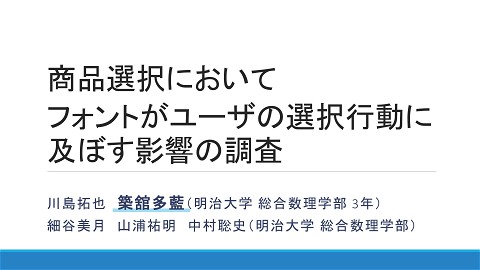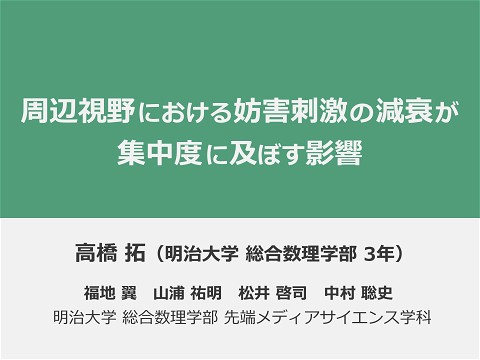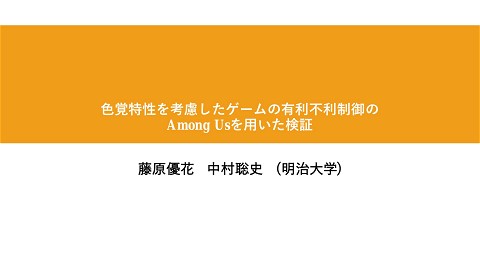Driving Experiment System Using HMDs to Measure Drivers’ Proficiency and Difficulty of Various Road Conditions
701 Views
July 01, 22
スライド概要
Driving Experiment System Using HMDs to Measure Drivers’ Proficiency and Difficulty of Various Road Conditions
HCI in Mobility, Transport, and Automotive Systems. HCII 2022
明治大学 総合数理学部 先端メディアサイエンス学科 中村聡史研究室
関連スライド
各ページのテキスト
Driving Experiment System Using HMDs to Measure Drivers’ Proficiency and Difficulty of Various Road Conditions Yukina Funazaki (Meiji University) Noboru Seto, Kota Ninomiya, Kazuyuki Hikawa, Satoshi Nakamura, Shota Yamanaka(Yahoo Japan Corporation)
Contribution • Developed an HMD-based driving experiment system that randomly generates various controlled road conditions. • Makes it possible to conduct experimental driving tests and monitor participants’ behaviors easier. • Showed that our system could judge the driver’s proficiency using the steering wheel operation in the driving trajectory of curves.
Contribution
Contribution
Contribution
Contribution
Background and Issue • Modern navigation systems recommend various routes. • It has become commonplace to use car navigation systems and app maps when driving.
Background and Issue • Modern navigation systems recommend various routes. • It has become commonplace to use car navigation systems and app maps when driving. Have you ever had this experience? • The navigation system led you to a very narrow street. • You followed the recommendation and found yourself on a mountain road.
Ultimate Goal Creating a navigation system that makes recommendations based on the ease of driving on that road.
Ultimate Goal Creating a navigation system that makes recommendations based on the ease of driving on that road. What is needed to achieve this? • A mechanism to estimate the difficulty of each road. • How long it will take to pass though that road • How difficult the road is This course Prediction time: 52 sec. Level: Easy This course Prediction time: 44 sec. Level: Difficult
The law of steering [Yamanaka et al. 2019] • To apply to driving, it is necessary to have a system that allows repeated experiments on short courses with slightly different conditions.
Proposed Method • Develop a HMD-based driving experiment system that can reproduce multiple geographical conditions in a three-dimensional space.
Proposed Method • Develop a HMD-based driving experiment system that can reproduce multiple geographical conditions in a three-dimensional space. • Unlike experiments with actual vehicles, experiments can be conducted many times in the same environment. • Generate many courses with slightly different conditions, such as curve angles, road widths, etc. • Set course can be presented randomly.
Driving Experiment Hypothesis Beginner drivers would turn and steer in curves more frequently as the difficulty of the road conditions increase.
Driving Experiment Hypothesis Beginner drivers would turn and steer in curves more frequently as the difficulty of the road conditions increase. Left turns Straight Line Right turns
Driving Experiment Hypothesis Beginner drivers would turn and steer in curves more frequently as the difficulty of the road conditions increase. Experimental Design • Complete five trials, took a five-minute break, and then complete another five trials. • In each trial, nine curves with different angles were presented at random. • Each participant drove 90 courses in total (nine angle conditions × ten trials).
Driving Experiment
Driving Experiment Instructions • • • • Drive at a reasonable speed and avoid contact with guardrails. They could stop the test if they felt VR sickness. This experiment was not a race. Begin driving as soon as the starting countdown was over.
Driving Experiment Participants in the experiment 18 university students (13 male and 5 female) • All of them owned a driver’s license. • Who had been driving for three years or more and drove regularly were designated as advanced drivers, and other participants were designated as beginners. → 5 participants were advanced drivers, and 13 were beginners.
Results and Discussion for both advanced and beginner • The advanced drivers could rotate the steering wheel appropriately at each angle • The beginner drivers moved the steering wheel several times to adjust the car’s position The amount of steering wheel operation rotated The steering wheel operation at each angle Angle
Results and Discussion The steering wheel operation at each angle for both advanced and beginner the steering wheel appropriately at each angle • The beginner drivers moved the steering wheel Time (seconds) • The advanced drivers could rotate several times to adjust the car’s position Angle
Results and Discussion Comparison of operation between advanced and beginner drivers • Beginner drivers steer heavily during curves more often Number of attempts Number of attempts The driving distance (m) The driving distance (m)
Results and Discussion Comparison of operation between advanced and beginner drivers • Beginner drivers steer heavily during curves more often Number of attempts Number of attempts The driving distance (m) The driving distance (m)
Results and Discussion • Steering wheel operation was found to be an indicator of driver proficiency and a potential indicator of road difficulty for beginner drivers → In this experiment, the radius was fixed, just the angle of the curve was changed → Future experiments on curves with varying radii will be considered.
Conclusion and Future Work • To achieve the goal of adapting and modeling the laws of steering to driving, we first developed an experimental system that allows the user to drive a short course many times.
Conclusion and Future Work • To achieve the goal of adapting and modeling the laws of steering to driving, we first developed an experimental system that allows the user to drive a short course many times. • Using the proposed system, we investigated features that serve as indicators of driver proficiency and road difficulty. • Advanced drivers could turn the steering wheel properly at any angle, whereas beginner drivers moved the steering wheel many times to adjust the car's position
Conclusion and Future Work • The steering wheel operation was useful in determining the driver’s driving proficiency as the results differed significantly between the advanced and beginner drivers → Suggests that the difficulty of driving may increase with the amount of necessary steering wheel movement.
Conclusion and Future Work • The proposed system is versatile and can be applied to other driving experiments • Research to produce sound during steering wheel operation [Matsuda 2022]
Summary Background: Using navigation systems when driving is common. Issue: Sometimes a narrow road is recommended even though you are not a good driver. Steering law: Model by experimenting with the same short course over and over again. Proposed method: Create a system that allows drivers to drive a short course many times in a 3D space. Experiment: Investigate whether there is a difference in operation between novice drivers and advanced drivers using the proposed system. Result: The novice driver often makes unnecessary steering maneuvers at curves, and the time required to pass the curves increases. Future Work: The proposed system is scalable and can be applied to other driving research.





